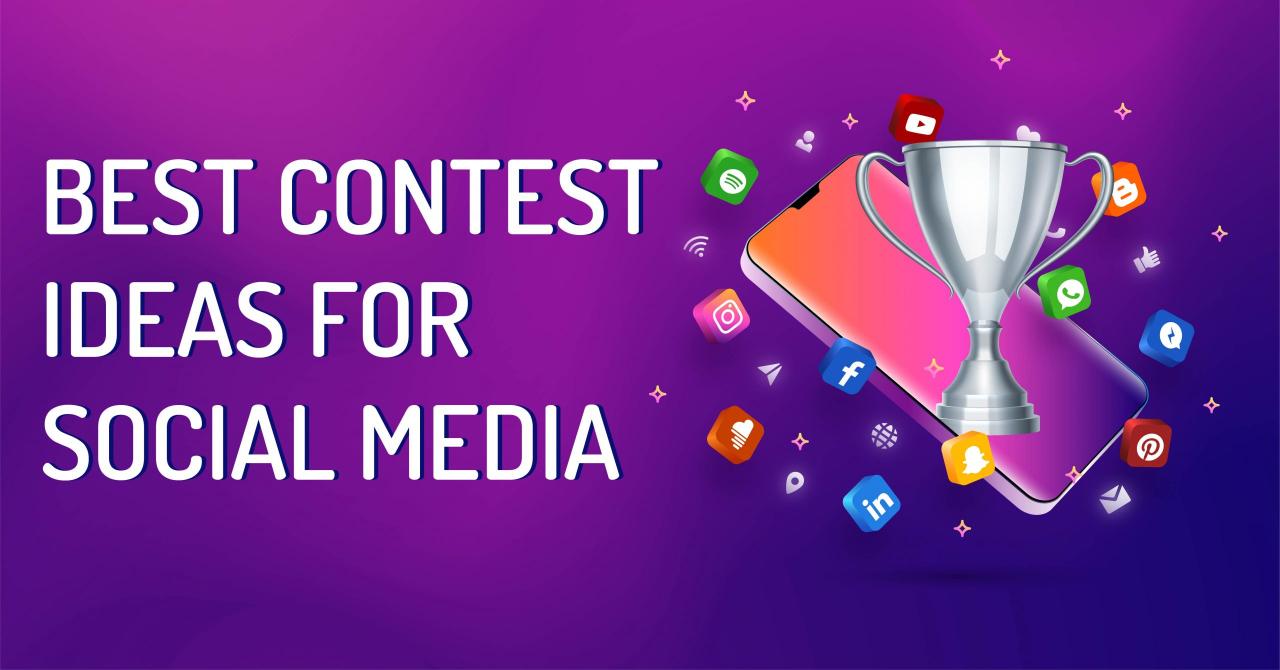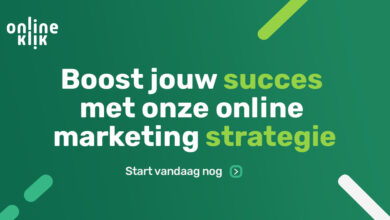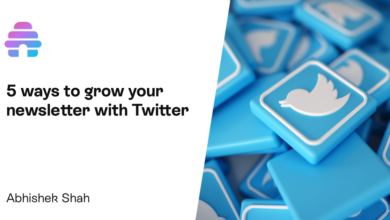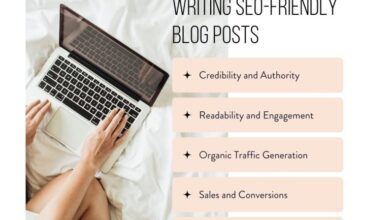
Social Media Marketing Giveaway Campaigns
Social Media Marketing Giveaway Campaigns: Want to boost your brand awareness and engagement? Running a successful giveaway campaign on social media can be a game-changer. It’s all about crafting a compelling strategy that attracts your target audience, offers a prize they truly desire, and leaves them wanting more. We’ll delve into the key elements, from choosing the right platform and prize to crafting engaging visuals and analyzing your results.
Get ready to unlock the power of giveaways!
This post will guide you through every step, from defining what makes a giveaway campaign truly successful to analyzing the results and optimizing for future campaigns. We’ll cover everything from choosing the perfect prize and platform to understanding the legal requirements and maximizing engagement through clever mechanics and promotion. Let’s turn those likes into loyal customers!
Defining Successful Giveaway Campaigns

Source: singlegrain.com
A successful social media giveaway is more than just offering a prize; it’s a strategic marketing tool designed to boost brand awareness, increase engagement, and generate leads. It requires careful planning and execution to achieve its objectives and avoid becoming a costly flop. The key is to create a campaign that resonates with your target audience, encourages participation, and ultimately benefits your business.A successful giveaway stands apart from an unsuccessful one primarily through its strategic planning and execution.
Unsuccessful giveaways often lack clear goals, target the wrong audience, or have poorly defined rules and participation methods. Conversely, successful giveaways are meticulously planned, aligning perfectly with marketing objectives, and employing tactics that maximize reach and engagement. They leverage the power of social media to create a buzz and foster a sense of community around the brand.
Key Characteristics of Effective Giveaways
Effective social media giveaways share several common traits. They are carefully designed to align with the brand’s overall marketing strategy and target a specific audience. The prize itself is relevant to the target audience and reflects the brand’s image. Clear, concise, and easily understood rules are crucial, minimizing confusion and maximizing participation. Promotion across multiple social media platforms amplifies reach, while interactive elements, such as user-generated content requests, encourage deeper engagement.
Finally, a well-structured timeline ensures the giveaway runs smoothly and efficiently, maximizing impact within a defined timeframe. For example, a company selling sustainable clothing might offer a giveaway of a complete outfit made from recycled materials, targeting environmentally conscious consumers through Instagram and Pinterest. The rules would be clearly stated in the post and readily available in a FAQ section.
Crucial Elements Differentiating Success and Failure
The difference between a successful and unsuccessful giveaway often boils down to a few key elements. Firstly, a clearly defined target audience is paramount. A giveaway targeting everyone will likely reach no one effectively. Secondly, the prize must be enticing and relevant to the target audience. A generic prize will not generate the same level of excitement as one that directly appeals to the audience’s interests.
Thirdly, the mechanics of participation must be simple and straightforward, encouraging broad participation. Complicated entry methods often lead to low participation rates. Finally, consistent and strategic promotion across multiple channels is essential for maximizing visibility and reach. Consider a cosmetics brand launching a new lipstick line. A successful giveaway might offer a collection of the new lipsticks to a select number of beauty influencers and their followers on Instagram, TikTok and YouTube.
The rules could be as simple as following the brand, liking the post and tagging three friends. An unsuccessful attempt might involve a complicated puzzle or a long list of requirements, ultimately discouraging participation.
Planning and Executing a Successful Giveaway
Planning a successful social media giveaway involves several key steps. First, define clear objectives – what do you hope to achieve with the giveaway? Increased brand awareness? Lead generation? Website traffic?
Next, identify your target audience and select a prize that resonates with them. Then, develop engaging content, including eye-catching visuals and a compelling call to action. The rules of participation must be clearly stated and easily accessible. A detailed promotional strategy is crucial, outlining the platforms, timing, and content to be used. Finally, track and analyze the results, measuring key metrics such as reach, engagement, and lead generation to assess the campaign’s effectiveness and inform future strategies.
For example, a fitness apparel company might aim to increase their Instagram followers by 20% through a giveaway of a year’s supply of their products. They would target fitness enthusiasts, offering a prize relevant to their interests. Promotion would involve targeted ads and collaborations with fitness influencers. Post-giveaway analysis would track follower growth and engagement metrics to evaluate success.
Choosing the Right Platform & Audience
Running a successful giveaway campaign hinges on selecting the right social media platform and targeting the perfect audience. A poorly chosen platform can lead to low engagement and wasted resources, while an ill-defined audience means your prize won’t resonate with potential participants. Understanding these key elements is crucial for maximizing your campaign’s reach and impact.The choice of platform significantly influences your campaign’s success.
Different platforms attract different demographics and user behaviors, meaning the ideal platform depends entirely on your target audience and the nature of your prize.
Platform Suitability for Giveaway Campaigns
Selecting the right platform requires considering the visual nature of your prize, your brand’s existing presence, and the demographics you’re trying to reach. Instagram, with its focus on visual content, excels for giveaways featuring aesthetically pleasing products like fashion items, beauty products, or home décor. Facebook, with its broad user base and established targeting options, works well for a wider range of prizes and allows for detailed audience segmentation.
Twitter’s real-time nature makes it suitable for quick, engaging giveaways with a focus on immediate participation. TikTok, with its younger demographic and emphasis on short-form video, is ideal for giveaways involving trendy products or experiences that lend themselves to creative video content.
Identifying the Ideal Target Audience for Various Giveaway Prizes
The type of prize directly influences the ideal target audience. A high-end tech gadget would attract a tech-savvy audience, likely male-dominated and with higher disposable income. Conversely, a giveaway of beauty products would likely appeal to a younger, female audience interested in beauty and self-care. Experiential prizes, such as concert tickets or travel vouchers, attract audiences with specific interests (e.g., music lovers, travel enthusiasts).
Understanding the inherent appeal of your prize is paramount in identifying the right audience.
Ideal Giveaway Participant Profile
Let’s imagine a giveaway for a high-end smartwatch. Our ideal participant might be a 25-35 year old professional, male or female, living in an urban area with a higher-than-average disposable income. They are likely tech-savvy, active on social media (particularly Instagram and Facebook), interested in fitness and health, and follow influencers in the tech and lifestyle space. Their online behavior would include frequent engagement with branded content, participation in contests and polls, and a demonstrated interest in similar products through likes, comments, and shares.
For a family-oriented prize like a weekend getaway, the profile would shift to focus on family demographics, income, and location, with engagement patterns reflecting family-related interests and activities.
Prize Selection & Strategy
Choosing the right prize is crucial for a successful giveaway campaign. It’s the carrot that entices your audience to participate, and the quality of that carrot directly impacts the success of your campaign. A poorly chosen prize can lead to low engagement, while a well-chosen one can generate significant buzz and brand awareness.The value and relevance of the prize significantly influence participation and engagement rates.
A high-value prize, such as a luxury item or a substantial cash amount, naturally attracts more entries. However, the relevance of the prize to your target audience is equally, if not more, important. A prize that resonates with your audience’s interests and aligns with your brand will drive higher engagement, even if its monetary value is lower. For instance, a niche tech gadget might attract a tech-savvy audience more effectively than a generic gift card, regardless of the gift card’s higher value.
Prize Ideas for Different Audiences
The selection of prizes should always be tailored to the specific audience you are trying to reach. Offering a prize that doesn’t resonate with your target demographic will result in low participation. Below is a table outlining three unique giveaway prize ideas, each targeting a different audience segment.
| Prize | Target Audience | Platform |
|---|---|---|
| A year’s subscription to a premium streaming service (e.g., Netflix, Spotify) bundled with a high-quality pair of noise-canceling headphones. | Young adults (18-25) who enjoy entertainment and technology. | Instagram, TikTok |
| A weekend getaway to a luxurious spa resort, including accommodation, meals, and spa treatments. | Affluent women aged 35-55 who appreciate wellness and relaxation. | Facebook, Pinterest |
| A complete set of professional-grade woodworking tools, including a high-quality saw, chisel set, and planer. | Men aged 25-45 who are interested in DIY projects and woodworking. | YouTube, Instagram |
Prize Value and Relevance Impact
The impact of prize value and relevance is multifaceted. High-value prizes, such as a new car or a significant cash prize, generate considerable excitement and attract a large number of participants. However, a highly relevant prize, even if of lower monetary value, can achieve higher engagement metrics. This is because participants are more likely to share and interact with a giveaway if the prize genuinely appeals to their interests and aligns with their lifestyle.
For example, a small business owner might be more excited to win a year’s worth of professional social media management services than a large cash prize, as the former directly supports their business goals.
Prize Sourcing Strategies at Various Budget Levels
Sourcing prizes effectively is key to maximizing your return on investment. Strategies vary depending on your budget:High Budget: Collaborate with brands to offer high-value prizes. This approach allows you to offer luxurious items without incurring the full cost. Partnering with complementary businesses expands your reach and strengthens brand credibility.Medium Budget: Consider purchasing prizes in bulk to leverage discounts.
This is particularly effective for smaller, more accessible prizes such as gift cards or branded merchandise. Online marketplaces can offer cost-effective options.Low Budget: Utilize existing inventory or create experiences. This could involve offering a free consultation, a personalized service, or a curated collection of your own products. This approach emphasizes the value of your brand and fosters a strong connection with your audience.
Alternatively, you could partner with smaller businesses willing to offer their products or services as prizes in exchange for exposure.
Giveaway Mechanics & Rules
Crafting the perfect giveaway requires more than just a tempting prize; it needs meticulously designed mechanics and crystal-clear rules. These elements are crucial not only for a smooth running campaign but also for legal compliance and maintaining transparency with your audience, building trust and preventing potential disputes. Let’s dive into the specifics.
Clear and concise rules are paramount for a successful giveaway. Ambiguity can lead to confusion and even legal issues. Think of your rules as a contract between you and your participants. They should be easily understood and readily accessible to everyone.
Giveaway Rules: A Bulleted List
Before outlining specific rules, remember to consult legal counsel, especially if your giveaway involves significant prizes or crosses international borders. Regulations vary, and professional advice ensures you’re operating within the law. Here’s a sample structure for your giveaway rules, adaptable to your specific campaign:
- Eligibility: Specify who can participate (age restrictions, geographical limitations, exclusions etc.). For example: “Open to legal residents of the United States aged 18 and older.”
- Entry Period: Clearly state the start and end dates and times of the giveaway. For example: “Giveaway begins October 26th, 2023, at 9:00 AM PST and ends November 5th, 2023, at 11:59 PM PST.”
- Entry Methods: Detail all ways participants can enter, assigning point values if necessary. For example: “1 entry for following our Instagram account, 2 entries for sharing this post to your story, and 5 entries for tagging three friends in the comments.”
- Prize Details: Describe the prize(s) precisely, including any limitations or restrictions. For example: “One (1) winner will receive a $500 Amazon gift card.”
- Winner Selection: Explain how the winner(s) will be chosen (random draw, judging, etc.). For example: “Winner will be selected randomly using a third-party app, and notified via direct message on Instagram within 48 hours of the giveaway’s end.”
- Odds of Winning: State the odds of winning, if possible. This enhances transparency. For example: “Odds of winning depend on the number of entries received.”
- Prize Claiming: Artikel the process for the winner to claim their prize (timeframe, required information, etc.). For example: “Winners must respond to the notification message within 72 hours to claim their prize. Failure to respond will result in the selection of an alternate winner.”
- Liability & Release: Include a statement releasing the sponsor from liability (check with legal counsel on wording). For example: “By entering, participants agree to release the sponsor from any liability associated with the giveaway.”
- Privacy Policy: Refer participants to your privacy policy regarding the use of their information. For example: “See our privacy policy at [link to privacy policy] for details on how we handle participant information.”
Giveaway Mechanics: Raffle, Contest, Sweepstakes
The mechanics you choose significantly impact your giveaway’s success and engagement. Each type has its own strengths and weaknesses.
| Giveaway Type | Description | Suitability |
|---|---|---|
| Raffle | Participants purchase entries (often for a charitable cause). Winner(s) are randomly selected. | Fundraising, building brand awareness, requires legal compliance regarding lottery laws. |
| Contest | Participants submit creative entries (photos, videos, essays, etc.). Winner(s) are chosen based on merit. | Driving user-generated content, showcasing skills/talent, promoting brand engagement. |
| Sweepstakes | Participants enter by completing a simple action (e.g., following, liking). Winner(s) are randomly selected. | Boosting follower count, increasing brand awareness, simple and easy to participate in. |
Maximizing Participation with Entry Methods
Strategic entry methods are key to driving participation and engagement. Offering multiple entry options increases the chances of people entering and interacting with your brand across different platforms.
Consider offering a tiered system, where some actions are worth more entries than others. This incentivizes deeper engagement. For example, following your Instagram account might be worth one entry, while sharing the post to their story might be worth five. Tagging friends could add even more entries. Remember to clearly state the value of each action in your rules.
Promoting the Giveaway: Social Media Marketing Giveaway Campaigns

Source: smbelal.com
Getting the word out about your giveaway is crucial for its success. A well-planned promotional strategy across multiple platforms will maximize reach and engagement, leading to a higher number of entries and increased brand awareness. Remember, the goal isn’t just entries; it’s building a genuine connection with your target audience.A multi-faceted approach is key. This involves not only spreading the news but also actively engaging with your audience to build excitement and anticipation.
Consistent posting and interactive elements are vital to keep the momentum going throughout the giveaway period.
Promotional Schedule
A detailed schedule ensures consistent promotion across all chosen platforms. This avoids sporadic bursts of activity and maintains engagement. Consider the peak times for your audience on each platform and schedule posts accordingly. For example, a weekday afternoon post on Instagram might reach a different audience than a weekend evening post on Facebook. The following is an example schedule, remember to tailor it to your specific audience and platforms:
| Day | Platform | Activity | Time |
|---|---|---|---|
| Monday | Story announcing giveaway with engaging visuals; post on feed | 12 PM, 6 PM | |
| Tuesday | Post on page with giveaway details and engaging video | 10 AM, 7 PM | |
| Wednesday | Series of tweets highlighting prize and entry mechanics | 1 PM, 5 PM, 9 PM | |
| Thursday | Re-share giveaway announcement with a call to action in the caption | 3 PM | |
| Friday | All Platforms | Reminder post/story emphasizing the giveaway closing date | Various times throughout the day |
Engaging Visual Content
Visuals are paramount in grabbing attention on social media. High-quality images and videos are more likely to be seen and shared. Consider the unique visual style of each platform when creating your content.
- Instagram: A vibrant, high-resolution image or short video showcasing the prize. For example, a lifestyle shot featuring the prize in a desirable setting, perhaps someone enjoying the prize, or a close-up showcasing its details. Consider using Instagram’s features like Reels or Stories for short, engaging clips.
- Facebook: A professional-looking image or video, perhaps a slightly longer video that tells a story about the prize or your brand. Consider using a carousel post to showcase multiple aspects of the prize.
- Twitter: A visually appealing image or GIF that is easily digestible within Twitter’s character limit. A simple graphic with text overlaying the prize image and key details works well.
Compelling Copy Examples
The words you use are just as important as the visuals. Your copy should be concise, exciting, and clearly communicate the giveaway’s details.
- Instagram: “✨GIVEAWAY ALERT!✨ We’re giving away [Prize]! To enter: 1. Follow us! 2. Like this post! 3. Tag 3 friends! Good luck! #giveaway #contest #[yourbrand] #[relevant hashtags]”
- Facebook: “🎉 Win [Prize]! 🎉 We’re excited to announce a giveaway to celebrate [occasion]! Enter now for a chance to win! [Link to entry form]. Share this post with your friends for an extra entry! #giveaway #contest #[yourbrand] #[relevant hashtags]”
- Twitter: “RT & Follow to win [Prize]! Giveaway ends [date]. #giveaway #contest #[yourbrand] #[relevant hashtags]”
Post-Giveaway Analysis & Optimization

Source: brandafy.com
Analyzing the results of your social media giveaway is crucial for understanding what worked, what didn’t, and how to improve future campaigns. Don’t just celebrate the winner; dig into the data to glean valuable insights for maximizing your ROI on future giveaways. A thorough post-giveaway analysis transforms a one-off event into a continuous improvement cycle for your social media marketing strategy.
Key Metrics for Assessing Giveaway Success
Understanding which metrics to track is the first step to a successful post-giveaway analysis. The metrics below provide a comprehensive overview of your campaign’s performance across various aspects.
| Metric | Description | Measurement Method | Interpretation |
|---|---|---|---|
| Reach | The total number of unique individuals who saw your giveaway post. | Use the built-in analytics of your chosen social media platform (e.g., Facebook Insights, Instagram Insights). | A high reach indicates effective promotion and broad audience engagement. Low reach suggests issues with targeting or promotion strategy. |
| Engagement (Likes, Comments, Shares) | The level of interaction with your giveaway post. | Use the built-in analytics of your chosen social media platform. Track likes, comments, and shares separately. | High engagement shows strong interest and post appeal. Low engagement may indicate a lack of compelling content or poor targeting. Analyze which types of engagement (likes vs. comments vs. shares) were most prevalent to understand what resonated most with your audience. |
| Website Traffic (if applicable) | The number of visitors driven to your website from the giveaway post. | Use website analytics tools (e.g., Google Analytics) to track referral traffic from your social media platform. | High website traffic indicates successful lead generation. Analyze which pages were most visited to understand user behavior and identify potential improvements to your website’s conversion funnel. |
| Entry Rate | The number of individuals who entered the giveaway compared to the number who saw the post. | Divide the number of unique entries by the reach. | A high entry rate signifies a strong call to action and compelling prize. A low entry rate suggests improvements are needed in the clarity of instructions, the attractiveness of the prize, or the overall campaign messaging. |
| Cost Per Acquisition (CPA) | The cost of running the giveaway divided by the number of new followers or leads acquired. | Divide the total cost of the giveaway (including prize, advertising spend, etc.) by the number of new followers or leads gained. | A low CPA indicates a cost-effective campaign. A high CPA suggests the need for more efficient targeting or a more compelling offer. |
Identifying Areas for Improvement
Analyzing the data from the table above will highlight areas needing attention. For example, low engagement might suggest that the post’s visuals or copy weren’t compelling enough. A low entry rate could mean the entry process was too complicated or the prize wasn’t enticing. High CPA might point to ineffective targeting or an over-reliance on paid promotion. Comparing your results to previous campaigns will also provide valuable insights into the effectiveness of different strategies.
Social media marketing giveaway campaigns are a fantastic way to boost engagement, but you need a strong platform to really make them shine. To reach a wider audience and maximize your giveaway’s impact, consider integrating your campaign with video marketing; check out this awesome guide on getting it on with youtube to learn how. After all, a successful YouTube presence can seriously amplify the reach of your social media giveaway campaigns, leading to more entries and brand awareness.
Actionable Steps for Optimization
Based on the analysis, take concrete steps to optimize future campaigns. If engagement was low, consider A/B testing different visuals, captions, and calls to action. If the entry rate was low, simplify the entry process, make it clear and concise. If CPA was high, refine your targeting parameters to reach a more engaged audience, consider alternative promotional methods, or adjust the prize to better align with your target audience’s preferences.
For instance, if a giveaway focused on a specific product garnered low engagement, consider shifting the focus to a more broadly appealing prize in future campaigns. Continuously analyzing and adapting your strategy based on data-driven insights is key to running successful social media giveaways.
Legal Considerations and Compliance
Running a successful social media giveaway campaign requires more than just engaging content and a great prize; it demands a thorough understanding and adherence to relevant laws and regulations. Ignoring legal aspects can lead to significant financial penalties, reputational damage, and even legal action. This section will highlight crucial legal considerations to ensure your campaign remains compliant and avoids potential pitfalls.Navigating the legal landscape of social media giveaways can be complex, varying by jurisdiction and the specifics of your campaign.
Understanding these complexities is essential to protect both yourself and your brand. Failure to comply can result in hefty fines, legal battles, and a severely tarnished brand image. This section Artikels key legal areas to consider, providing examples to help you create compliant and successful campaigns.
Giveaway Rules and Regulations
Clearly defined rules are paramount. These rules should be readily accessible to all participants and explicitly Artikel eligibility criteria, entry methods, prize details, judging criteria (if applicable), and the timeline of the giveaway. Ambiguity can lead to disputes and legal challenges. For instance, specifying the age requirement (e.g., 18 years or older) is crucial, as is clearly stating any geographic restrictions.
Furthermore, if your giveaway involves a purchase, you must comply with relevant advertising and consumer protection laws. For example, the rules should explicitly state that a purchase is not necessary to enter, and participation is not contingent upon purchase if that is the case. Vague or incomplete rules can create confusion and open the door to legal challenges.
Privacy and Data Protection
Collecting personal data from participants necessitates compliance with data protection laws like GDPR (in Europe) and CCPA (in California). Your rules must clearly state how participant data will be collected, used, and protected. This includes obtaining explicit consent for data collection and providing a clear privacy policy. Failing to comply with these regulations can result in substantial fines and damage to your brand’s reputation.
For example, your privacy policy should explicitly state how long you will retain the data, what purposes it will be used for, and how participants can access or delete their information.
Disclaimers and Disclosures
Including appropriate disclaimers and disclosures in your giveaway rules and promotional materials is crucial. This might include disclaimers regarding sponsorships (if applicable), liability limitations, and the random selection process. For example, a disclaimer might state: “This giveaway is in no way sponsored, endorsed, or administered by, or associated with, [Social Media Platform Name].” Another crucial disclosure would be to clearly state that the sponsor is not responsible for lost, stolen, or damaged prizes.
Clear and concise disclaimers help protect you from potential liability.
Intellectual Property Rights
If your giveaway involves using copyrighted materials, trademarks, or other intellectual property, ensure you have the necessary rights and permissions. Unauthorized use can lead to infringement claims and legal action. For example, if you are using images or music in your promotional materials, ensure you have obtained the necessary licenses or permissions from the copyright holders. This is particularly important if you are using user-generated content.
Sweepstakes and Lottery Laws
Depending on the structure of your giveaway, it might be considered a lottery, which is heavily regulated in many jurisdictions. Lotteries typically involve consideration (payment or purchase), chance, and a prize. To avoid violating lottery laws, carefully design your giveaway to eliminate any element of consideration, ensuring participation is free and not contingent on a purchase. This means clearly stating that no purchase is necessary to enter and win.
Examples of Legal Disclaimers, Social media marketing giveaway campaigns
“This giveaway is in no way sponsored, endorsed, administered by, or associated with Facebook, Instagram, or any other social media platform.”
“By entering this giveaway, you agree to release and hold harmless [Your Company Name] from any liability associated with the giveaway.”
“No purchase necessary to enter or win. A purchase will not increase your chances of winning.”
“Odds of winning depend on the number of entries received.”
Last Word
Mastering social media marketing giveaway campaigns isn’t just about offering a freebie; it’s about building a genuine connection with your audience. By thoughtfully planning your campaign, selecting the right prize and platform, and engaging in post-campaign analysis, you can create a powerful marketing tool that drives brand awareness, increases engagement, and ultimately boosts your bottom line. So, get creative, get strategic, and get ready to watch your followers grow!
Essential FAQs
How long should a giveaway run for?
The ideal duration depends on your goals and platform. Shorter giveaways (1-2 weeks) create urgency, while longer ones (4-6 weeks) can build anticipation. Experiment to see what works best.
What if I don’t have a large budget for prizes?
Don’t worry! Partner with other businesses for cross-promotional giveaways or offer experiences instead of expensive products. Creativity is key!
How do I prevent fraudulent entries?
Use clear rules and monitor entries closely. Consider using tools to detect fake accounts or multiple entries from the same person. Transparency and clear rules are crucial.
What if my giveaway doesn’t get many entries?
Analyze your strategy. Was the prize appealing? Did you promote effectively? Were your rules clear? Learn from the experience and adjust your approach for future campaigns.





